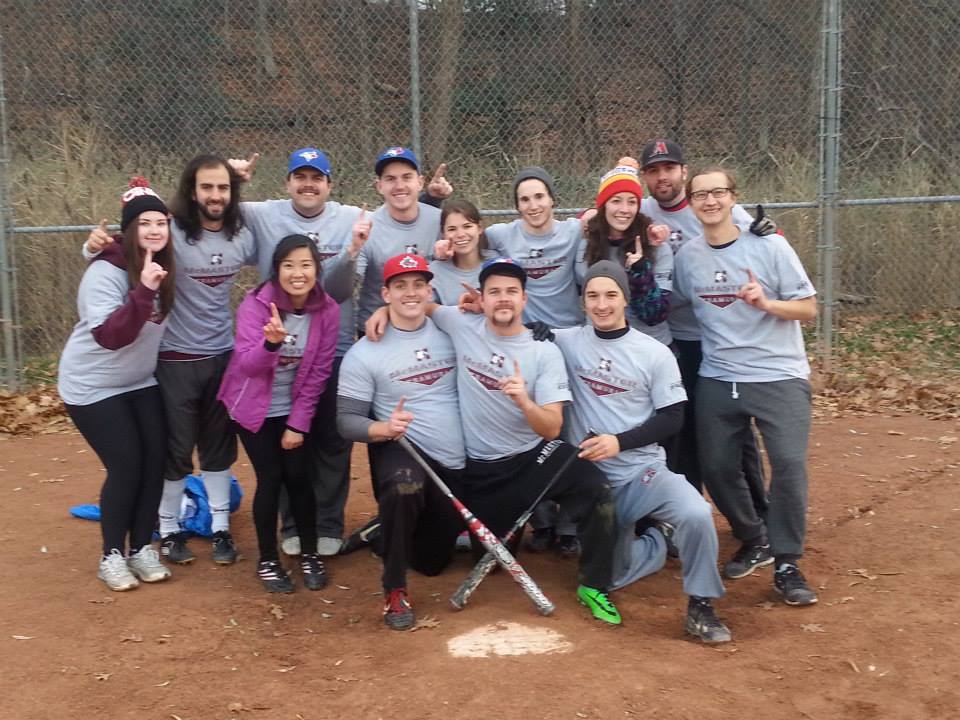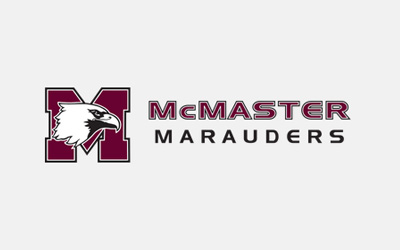Programs & Services: Intramural Sports
Intramural 3-Pitch Softball
Sport leagues and tournaments for the entire McMaster community, beginner to advanced, individual or team: We want to play with you!
 Need an accommodation? Submit Accommodation Request
Need an accommodation? Submit Accommodation Request
For more information: intramurals@mcmaster.ca
Fall Leagues
- When are leagues and tournaments in this sport offered? What PlayStyles are available?
Check the Sport Calendar on the 'SPORTS' tab of our Intramural Sports page.
- Who can play Intramural Sports at McMaster? How do I register?
Check the 'REGISTER' tab of our Intramural Sports page.
- Registration Required
Facilities
3-Pitch Softball Rules
Canadian Amateur Softball Rules shall apply with the following amendments and/or additions:
A) PLAYERS:
1. Open: Maximum of 10 players are allowed on the field at one time.
a) Minimum: 7 players.
2. Corec: Maximum of 10 players are allowed on the field at one time: 6 men, 4 women.
a) Minimum: 7 players (must include at least 3 women)
b) Teams with only 3 women will receive an automatic out whenever the 4th woman is scheduled to bat, and must designate the batting lineup position of the ‘ghost batter’ at the start of the game. If playing with only 3 women, the team may only field 9 defensive players (the 4th woman's spot is left vacant).See Rule C5c for batting order restrictions.
c) Women may substitute for men in the lineup without penalty.
B) GAME SETUP:
1. The field shall be set up such that the perpendicular distance between each base is 60 Feet.
2. Safety Bag at First: First base will be a ‘safety bag’ – white on the left, orange on the right; base runners use the orange bag when running through first base, fielders use the white bag. On plays at first base when the batter/runner is running through the bag, players touching the wrong side of the bag will be called out/safe at the discretion of the umpire.
3. Pitching Rubber: A pitching rubber will be placed on a direct line between 1st and 3rd bases, approximately 15 metres from home-plate.
4. Plays at home plate: No Contact Allowed!
a) Point of no return: A line will be marked halfway between third base and home plate. A runner advancing from third base must continue home if he/she has passed this line. Play then becomes a forced out at home. Runners must cross the line extending from home plate to the screen -- they must not touch the plate; similarly, the fielding team must touch home plate, and cannot tag a runner who has past the point of no return.
b) There will NEVER be need for contact at home plate! If the catcher is forced by an errant throw to break contact with home plate, he/she must retrieve the ball and tag home plate for the out. He/she must NEVER tag the runner once the runner has passed the point of no return. If tagged, the runner will be called safe, and defensive team warned.
c) If a base runner inadvertently touches home plate when, in the Umpire's judgment, there is clearly no play being made at home the base runner is not out; however, if a play is being made at home, and the base runner touches home plate, he/she will be automatically called out.
5. A ball is Out of Play when it clears the fence/enters the dugout entrance.
a) Play will be called, and base runners will be awarded the base in front of them; if a runner is between bases, they will be awarded the base in front of them, plus one additional base.
6. A fair ball in the infield must remain in fair territory until it reaches the outfield to be considered fair. A ball must bounce in fair territory once to be fair in the outfield. A ball passing over the base at third or first in the air and landing foul is a foul ball.
7. Metal cleats are not allowed; plastic/rubber spikes only!
C) GAME PLAY:
Fielding
1. Players in the field must be stationed in fair territory, except the catcher who must remain against the backstop. Teams who are short of players may choose ANY position, including catcher, not to be filled. A team shall consist of 5 infielders (catcher, 1st base, 2nd base, 3rd base, shortstop), 3 outfielders and 2 rovers. Fielders other than the catcher may play anywhere with the following exceptions:
a) No fielders may be inside of the baselines until the batter has made contact with the ball. Outfielders and rovers must be minimum 20 meters (marked by cone/paint) from the edge of the infield until the batter has made contact with the ball.
Batting/Pitching
1. The team at bat supplies the pitcher.
a. Pitching Rubber: The pitcher must deliver the ball from the pitching rubber. If they are closer to home plate, the umpire will immediately call the play dead, and count the pitch in the 3-pitch total.
b. Pitcher's Helmet: The pitcher must wear the provided helmet whenever on the mound.
c. Pitching Screen: Use of the pitching screen is mandatory. Pitchers must have one foot on the rubber at the start of the pitch. After releasing the pitch the pitcher must be behind the screen.
i) If a pitcher is struck by a batted ball (in the air or on the ground, before it hits anything else like the screen, fence, or a defensive player) the ball is dead and the batter is declared out.
ii) If the pitching screen is hit by a batted ball, ball is dead and considered a 'no pitch' towards the 3-pitch count.
iii) If the pitching screen is hit by a ball thrown by the defensive team, play is live.
2. Each batter receives three pitches regardless of where their pitcher throws them (i.e., there are no balls or strikes, just ‘pitches’).
3. If a batter fouls their third pitch, they are out.
4. Each team is allowed a maximum of 10 batters per inning, except in the final inning which will remain 'open' (standard 3 outs apply).
a) There may be as many players in the batting order as a team would like, however, they must stay in that order.
b) When the tenth batter comes to the plate, the umpire will announce 'last batter'. Play is terminated when home plate is touched by a member of the fielding team in possession of the ball, or when the third out is recorded – whichever comes first.
c) The batting order may not have more than seven (7) male batters in a row at any time in the game. This includes when the bottom of the order loops back to the top.
5. No one may intentionally bunt the ball. Relative to each participant's ability, anything less than a full-swing is not allowed.
6. The plate is in fair territory. If a batted ball hits the plate, the ball is alive and fair.
7. Home Runs Over the Fence: A home-run ball must be retrieved by the batting team before a subsequent home-run will be counted.
a. If the previous home-run ball is not retrieved, the next ball hit over the outfield fence is counted as a ground-rule double.
b. Every ball hit over the outfield fence will be scored as a ground-rule double unless the immediately previous ball was retrieved. This covers for a team that is unable to find a previously hit ball: The next ball hit over will count as a ground-rule double, but if that ball is retrieved, the next home-run counts, and so on.
Base Running
1. There are no lead-offs. Base runners may leave the base only after the ball is hit. A base runner who loses contact with the bag prior to the batter making contact is immediately called out.
2. A batter or base runner cannot interfere with a batted ball. If he/she does, they are out; if the interference was part of an attempt to break up a double play, etc., the umpire may call other runners out as well. The base runners must return to the last base touched by them unless forced to the preceding base.
3. A batted ball that strikes the batter outside the batter's box is alive but the batter is out.
4. A base runner interfering with a fielder in the process of fielding a ball is out and the ball is dead.
5. A base runner hit by a fair ball is out unless the ball has passed through a fielder and no other fielder had a chance to field the ball.
6. Pinch runners are allowed at any time for injured players.
a) The pinch runner will be the last recorded out of the same gender.
b) A player incapable of running from home to first may still bat with a pinch runner from home. The pinch runner must start from the backstop from a point on the first base side where the third base line extended meets the backstop.
c) Pinch runners substituting for a batter (starting from home plate) must be announced by their team; unannounced pinch runners will be automatically called out.
7. Sliding: No sliding! Anywhere! A base runner that slides will be automatically called out.
8. Left-turn at first base: At the discretion of the umpire, a batter/runner who turns left after running through first base will only be considered 'live' and susceptible to being tagged out if an attempt is made to advance towards second. A batter/runner will not be called out for unknowingly turning left and walking back to first base.

